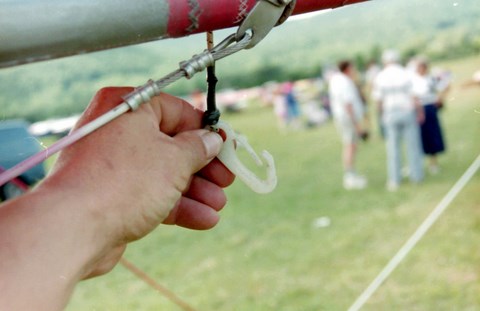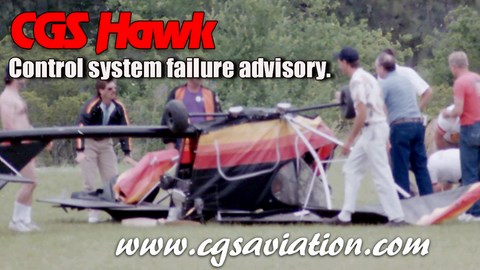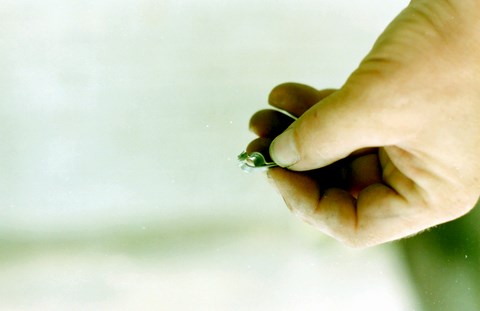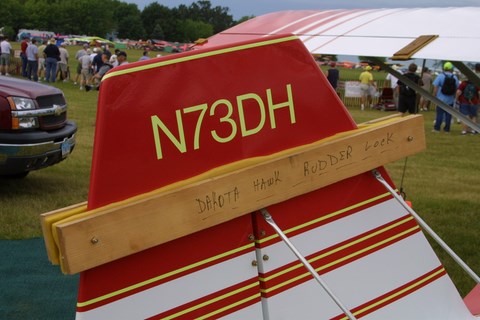Ultralight aircraft control system failure
Ultralight Aircraft Control system:
The control system is a part of the craft that has to be checked thoroughly! Some older designs used ROPE, to operate control systems . Do not fly any aircraft that uses rope and knots to operate a control system. Have these replaced with steel cable, using proper NICOS, and AN fittings. shows a manufacturer using a plastic clip to connect rope to control system.
In Canada one of these, operating the elevator control system, failed during winter conditions, when under load it cracked and broke resulting in the owner of the aircraft being hospitalized for 6 months. The aircraft was completely destroyed!
Another problem in enclosed ultralights is dirt and debris collecting around the control cable where it enters, a plastic outer cable. The dirt acts much like sandpaper or a file, resulting in the cable fraying and failing . If the outer plastic coating moves in the retaining clamp, it allows metal on metal contact, resulting in failure of the control cable, or failure of the retaining clamp.
This can result in loss of elevator or rudder control as happened at Sun N fun, causing a CGS Hawk to crash.
http://www.sportaviationmagazine.com - CGS Hawk elevator control system failure advisory.
The following CGS Hawk service bulletin is one the manufacturer issued several years ago. It is being repeated here because of the manufacturer's concern that they were not widely publicized at the time and that many Hawk owners, especially those who have re-purchased used craft may not be aware of these problems that need to be addressed.
Issued by MANUFACTURER
Service bulletin 4-20-89B dated:
April 20, 1989
MODELS AFFECTED: All CGS Hawk Aircraft
SUBJECT: Control Cable Erosion
SUMMARY: During flight at approximately 20 feet of altitude and a speed of 60-80 mph, the up elevator cable broke resulting in an immediate slip to the ground, striking a wing and then flipping the plane on its back. Inspection showed the location where the cable broke had been reduced in cross section by approximately 65%.
Only 2 strands out of7 were intact. The area of erosion was where the cable and nylon housing exit the main tube near the tail. Further inspection showed that the rudder cables had 2 frayed strands. The aileron cables showed no signs of wear.
REQUIRED ACTION:
Inspect the rudder and elevator cables where they exit the boom tube. You can loosen the clamps and slide the nylon housing forward to examine the cables. It may be necessary to trim off some of the housing. If you see any wear on your cables, replace them and please send the worn portion of your old cable to CGS along with the amount of time in service, and whether the cable is for the up or down elevator, or right or left rudder.
In any event, if any black powder can be seen through the housing, or if you have 500 hours time on your Hawk, replace the cables.
Other control system failures may result from the cable rubbing against tubing or metal. If your aircraft control system uses clips and rings to connect push pull tubes or cables to a elevator or rudder it is recommended that this be replaced with AN nuts and bolts .
Many ultralights use teleflex cables to operate control systems. When subjected to environmental conditions such as severe wind, these have failed, or partially failed.
I test flew Buccaneer SX without noticing that the cable, operating the ailerons was cracked. It failed in a turn it resulted in a spiral turn, luckily it was not very steep and I was able to right it with rudder, and landed safely.
Check Ultralight control systems for wear
When storing a craft outside it is suggested that you make up a set of aileron/elevator stops.
Check all moving parts of the control system for wear or damage. Look at the aileron hinges for cracks. In an aircraft using rivets look for loose fitting hinges, a sign of rivet wear.
Examine elevator horns, aileron push pull tubes, rudder pedals, at attachment points for wear at hinges or eye bolts.
Elevator horn $ 50.
Teleflex cable $ 46 - $ 50.
Steel control cable per ft. $ .30 - $ .50
NICO press stops $ .20 - $ .85 (each)
Elevator/aileron stop material
2 lengths 10 ft. 3/4 inch copper tubing (available at any hardware store) $ 6. - $ 8.
10 feet pipe insulation $ 4. - $ 5.
2- 3 inch bolts and wing nuts $ 2.




